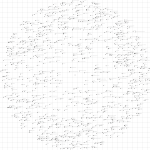Early Sci-Fi RPGs
The earliest science-fiction RPGs were set on planets or within starships and did not include much at all regarding the stellar neighborhoods around them:
2D Empire Building
In 1977, Traveller [1] by Game Design Workshop started humbly with a simple system of plotting 2D "space sectors" on hex paper.
In the 40+ years since, that humble beginning has lead to a massive sprawling empire of more than 11,000 systems detailed on a random-generated 2D map [2].
Since Traveller's earliest days, a recurring question is "why not use 3D star data and make the map 3D?"
The usual answers are ease of use and simpler math.
On a 2D map, you can simply "walk" your fingers from start to end and count along the way.
In 3D mapping, this doesn't work.
With a 2D map, the Distance between two star coordinates equals the Square Root of ( (EndingX - StartingX)^2 + (EndingY - StartingY)^2 )
Thanks Pythagoras!
With a 3D map, the math is ... less easy:
Distance = Square Root of ( (EndingX - StartingX)^2 + (EndingY - StartingY)^2 + (EndingZ - StartingZ)^2 )
Science-Fiction RPGs with Realistic Maps
Despite the ease of use and math friction, that did not stop some game companies exploring 3D star maps.
The earliest game based on a 3D map I have is Universe [3] by SPI from 1981.
Game Design Workshop released a futuristic Twilight 2000 update in 1986 called Traveller: 2300 [4] including a star map based on Gliese's Near Star Catalog.
In 1993 TSR published Amazing Engine: Bughunters [5] with a map very similar to the map from SPI's universe (possibly because TSR had acquired SPI years before).
Despite the occasional forays into realistic star maps, many or most games followed Traveller's lead, just including their own 2D maps of space to explore or systems to build 2D maps.
Recent Developments
In recent years, the availability of high-quality near star data and the computer power to easily manipulate it has led to a number of games which give 2D presentations of 3D star data.
Three examples:
This allows you to intermix and interchange these maps and their data, or use data from these games to expand the others.
Building Your Own Realistic 2D *and* 3D Starmap From The Same Data
Even better, the 3D star maps described above all build from real astronomical data sources and you can too.
With the release of Traveller: 2300, gaming guru Winchell Chung began "Project Rho" to explore, explain, and expand on 3D star mapping for his own personal interest, which he also moved onto the world wide web to share with others.
Over time, Project Rho expanded into Atomic Rockets, a massive reference site about all things spaceflight.
OBLIGATORY WARNING: WARPED SPACETIME!
Visiting Project Rho and/or Atomic Rockets may result in lost time and productivity - these sites are a very cool vortex of science fiction information deceptively easy to get lost in for hours or days.
Winchell Chung put together the HabHYG [11] star maps and data and makes them freely available to improve the state of star mapping in literature and games.
From the link, you can download PNG and PDF map images, data spreadsheets, connection lists, and the StereoStar program with data files for:
These maps can be used as-is for plenty of science-fiction role-playing and have 3D coordinate data and can be plotted in 2D allow you to use and re-use them as you see fit.
The spreadsheet data format is documented for use with other tools.
3D Map Management
If you would like to visualize the 3D space, as well as track GM friendly information about planets, stations, stars, and empires within it, the "go to" tool for 3D star map management is AstroSynthesis [12] by NBOS Software.
Being able to plot, rotate, pivot, and pan through the 3D map data, and tag GM information to anything is a great management help.
My favorite feature of AstroSynthesis is one that touches on the hardest part of star map management... building the solar systems around those stars.
AstroSynthesis can build a stellar system from your star data with push-button ease.
This can save a GM many hours spent throwing dice at planet-building charts which is the procedure generally used within RPGs such as Traveller, FTL: 2446 and Midnight at the Well of Souls, or Traveller: 2300/2300 AD.
A Final Thought...
Of course, all of this may be far too much time, effort, and/or money for the harried GM to bother with.
If you just need a space map, and you need it right now, you cannot go wrong with The Only Sci-Fi Star Chart You'll Ever Need [13].
Disclaimer and Disclosure
Not every science-fiction RPG could be covered here.
This list primarily touches on games contained in the my personal library.
I provide financial support to Atomic Rockets through Patreon.
I am also an AstroSynthesis license holder and long-ago script contributor.
References
[1] https://en.wikipedia.org/wiki/Traveller_(role-playing_game)
[2] https://www.travellermap.com
[3] https://en.wikipedia.org/wiki/Universe_(role-playing_game)
[4] https://en.wikipedia.org/wiki/2300_AD
[5] https://en.wikipedia.org/wiki/Amazing_Engine
[6] https://www.drivethrurpg.com/product/192332/Near-Space
[7] https://www.stellagamapublishing.com/
[8] https://www.paulelliottbooks.com/hostile.html
[9] https://www.paulelliottbooks.com/hostile-resources.html
[10] https://www.geeknative.com/65748/alien-rpg-stars-of-the-middle-heavens-and-campaign-play/
[11] http://www.projectrho.com/public_html/starmaps/mapindex.php#winch
[12] https://nbos.com/products/astrosynthesis
[13] https://boingboing.net/2017/04/17/every-sci-fi-star-map.html
The earliest science-fiction RPGs were set on planets or within starships and did not include much at all regarding the stellar neighborhoods around them:
- 1975 Empire of the Petal Throne set on the world of Tékumel.
- 1975 Blackmoor set on the worlds Mystara, Greyhawk, Wilderlands, and Pelinore over the years.
- 1976 Metamorphosis Alpha set inside the massive starship Warden.
2D Empire Building
In 1977, Traveller [1] by Game Design Workshop started humbly with a simple system of plotting 2D "space sectors" on hex paper.
In the 40+ years since, that humble beginning has lead to a massive sprawling empire of more than 11,000 systems detailed on a random-generated 2D map [2].
Since Traveller's earliest days, a recurring question is "why not use 3D star data and make the map 3D?"
The usual answers are ease of use and simpler math.
On a 2D map, you can simply "walk" your fingers from start to end and count along the way.
In 3D mapping, this doesn't work.
With a 2D map, the Distance between two star coordinates equals the Square Root of ( (EndingX - StartingX)^2 + (EndingY - StartingY)^2 )
Thanks Pythagoras!
With a 3D map, the math is ... less easy:
Distance = Square Root of ( (EndingX - StartingX)^2 + (EndingY - StartingY)^2 + (EndingZ - StartingZ)^2 )
Science-Fiction RPGs with Realistic Maps
Despite the ease of use and math friction, that did not stop some game companies exploring 3D star maps.
The earliest game based on a 3D map I have is Universe [3] by SPI from 1981.
Game Design Workshop released a futuristic Twilight 2000 update in 1986 called Traveller: 2300 [4] including a star map based on Gliese's Near Star Catalog.
In 1993 TSR published Amazing Engine: Bughunters [5] with a map very similar to the map from SPI's universe (possibly because TSR had acquired SPI years before).
Despite the occasional forays into realistic star maps, many or most games followed Traveller's lead, just including their own 2D maps of space to explore or systems to build 2D maps.
Recent Developments
In recent years, the availability of high-quality near star data and the computer power to easily manipulate it has led to a number of games which give 2D presentations of 3D star data.
Three examples:
- 2016 Near Space[6] by Stellagama [7]
- 2017 Hostile [8] by Zozer Games Free Maps and Other Downloads [9]
- 2020 "The Stars of the Middle Heavens" map [10] by Fria Ligan/Free League for the ALIEN RPG.
This allows you to intermix and interchange these maps and their data, or use data from these games to expand the others.
Building Your Own Realistic 2D *and* 3D Starmap From The Same Data
Even better, the 3D star maps described above all build from real astronomical data sources and you can too.
With the release of Traveller: 2300, gaming guru Winchell Chung began "Project Rho" to explore, explain, and expand on 3D star mapping for his own personal interest, which he also moved onto the world wide web to share with others.
Over time, Project Rho expanded into Atomic Rockets, a massive reference site about all things spaceflight.
OBLIGATORY WARNING: WARPED SPACETIME!
Visiting Project Rho and/or Atomic Rockets may result in lost time and productivity - these sites are a very cool vortex of science fiction information deceptively easy to get lost in for hours or days.
Winchell Chung put together the HabHYG [11] star maps and data and makes them freely available to improve the state of star mapping in literature and games.
From the link, you can download PNG and PDF map images, data spreadsheets, connection lists, and the StereoStar program with data files for:
- 52 stars within 15 l.y.
- 111 stars, 17 habitable, within 20 l.y.
- 277 stars, 51 habitable, within 30 l.y.
- 572 stars, 121 habitable, within 40 l.y.
- 998 stars, 211 habitable, within 50 l.y.
These maps can be used as-is for plenty of science-fiction role-playing and have 3D coordinate data and can be plotted in 2D allow you to use and re-use them as you see fit.
The spreadsheet data format is documented for use with other tools.
3D Map Management
If you would like to visualize the 3D space, as well as track GM friendly information about planets, stations, stars, and empires within it, the "go to" tool for 3D star map management is AstroSynthesis [12] by NBOS Software.
Being able to plot, rotate, pivot, and pan through the 3D map data, and tag GM information to anything is a great management help.
My favorite feature of AstroSynthesis is one that touches on the hardest part of star map management... building the solar systems around those stars.
AstroSynthesis can build a stellar system from your star data with push-button ease.
This can save a GM many hours spent throwing dice at planet-building charts which is the procedure generally used within RPGs such as Traveller, FTL: 2446 and Midnight at the Well of Souls, or Traveller: 2300/2300 AD.
A Final Thought...
Of course, all of this may be far too much time, effort, and/or money for the harried GM to bother with.
If you just need a space map, and you need it right now, you cannot go wrong with The Only Sci-Fi Star Chart You'll Ever Need [13].
Disclaimer and Disclosure
Not every science-fiction RPG could be covered here.
This list primarily touches on games contained in the my personal library.
I provide financial support to Atomic Rockets through Patreon.
I am also an AstroSynthesis license holder and long-ago script contributor.
References
[1] https://en.wikipedia.org/wiki/Traveller_(role-playing_game)
[2] https://www.travellermap.com
[3] https://en.wikipedia.org/wiki/Universe_(role-playing_game)
[4] https://en.wikipedia.org/wiki/2300_AD
[5] https://en.wikipedia.org/wiki/Amazing_Engine
[6] https://www.drivethrurpg.com/product/192332/Near-Space
[7] https://www.stellagamapublishing.com/
[8] https://www.paulelliottbooks.com/hostile.html
[9] https://www.paulelliottbooks.com/hostile-resources.html
[10] https://www.geeknative.com/65748/alien-rpg-stars-of-the-middle-heavens-and-campaign-play/
[11] http://www.projectrho.com/public_html/starmaps/mapindex.php#winch
[12] https://nbos.com/products/astrosynthesis
[13] https://boingboing.net/2017/04/17/every-sci-fi-star-map.html
Last edited:



